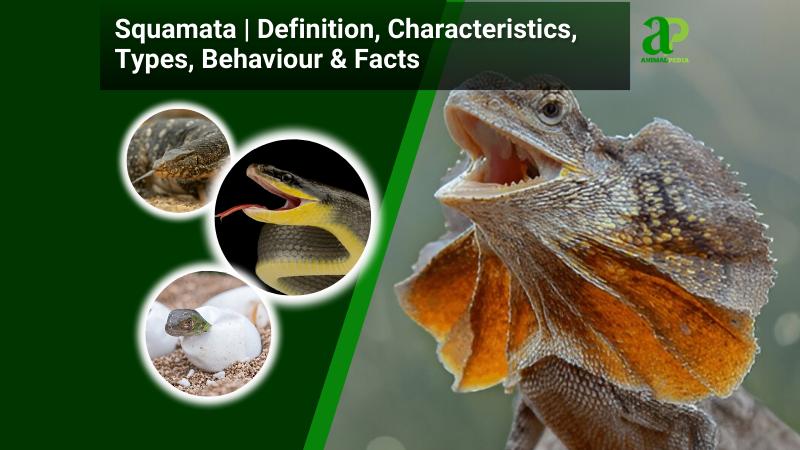Tiger snakes (Notechis scutatus), also called mainland tiger snakes, are highly venomous elapids native to southern Australia, including Tasmania and coastal islands like Kangaroo Island. They exhibit striking banded patterns—yellow, olive, or black—mimicking tiger stripes, with lengths averaging 3.9 feet (1.2 meters) but reaching up to 6.6 feet (2 meters). Although they are strong swimmers and thrive in coastal heathlands, they are true terrestrial hunters. This separates them from their fully-marine elapid relatives, the Coral Reef Snake, which live and hunt exclusively in the ocean.”
As apex predators in their ecosystems, tiger snakes display bold hunting tactics. They actively pursue prey, using ambush or active chase, targeting frogs, lizards, small mammals, and birds. Tiger snake diet adapts to local availability, with some populations specializing in seabird chicks. Tiger snake venom which rapidly immobilizes prey is neurotoxic. Human encounters are rare but dangerous, as tiger snakes can become defensive when threatened, leading to potentially fatal bites if untreated.
Tiger snakes mate in spring (September–November), with males engaging in combat to secure mates. Females lay 20–30 eggs in summer, often in concealed sites like burrows. Incubation lasts 9–12 weeks, with hatchlings emerging at 10–12 inches (25–30 centimeters). Juveniles are independent, hunting small prey immediately. They reach maturity in 2–3 years and may live up to 15 years in the wild.
Tiger snakes inhabit diverse environments, from Tasmanian highlands to mainland marshes. They favor areas near water, supporting their amphibian-heavy diet. Seasonal flooding influences their movement, pushing them to higher ground. Their adaptability to urban fringes increases human-wildlife conflict risks.
This article explores tiger snakes’ morphology, predatory behavior, reproduction, and habitat preferences, offering insights into their ecological role and conservation needs. Understanding these elapids fosters appreciation for Australia’s biodiversity and informs safety measures.

What Do The Tiger Snakes Look Like?
Tiger snakes, elapids that possess venom, have a slender, muscular body that averages 3.9 feet (1.2 meters) long, with some reaching 6.6 feet (2 meters). Their skin displays smooth, glossy scales with a banded pattern—yellow, olive, or black—resembling tiger stripes, a hallmark distinguishing them from other Australian snakes. The head is broad, slightly triangular due to venom glands, with large, piercing eyes and a flicking, forked tongue for sensing prey.
The neck is narrow, blending into a sinuous body that tapers to a short, pointed tail. Unlike limbed reptiles, tiger snakes lack limbs or claws and rely on undulating locomotion. Their vibrant, alternating bands contrast sharply with the uniform or blotched patterns of similar species, such as the brown snake (Pseudonaja textilis), making their coloration a key identifier.
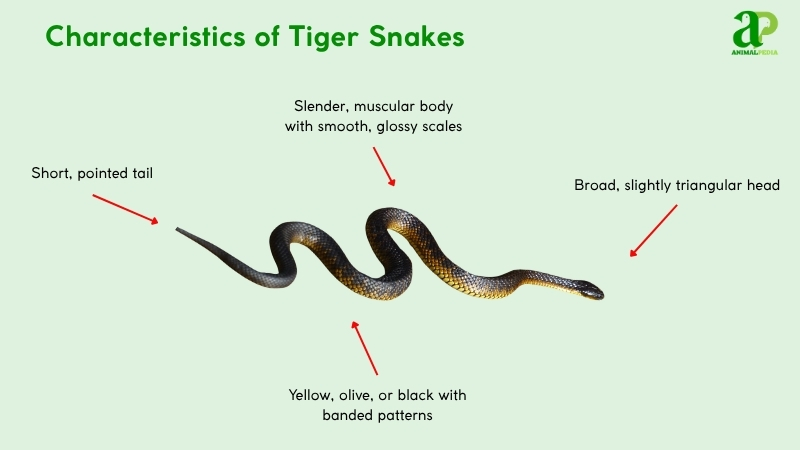
Compared to the brown snake, tiger snakes have a more robust build and distinct banding, whereas brown snakes often appear uniformly brown or mottled. Their scale texture is smoother than the keeled scales of some vipers, aiding in swift movement across diverse terrains.
How Big Do Tiger Snakes Get?
Tiger snakes typically measure 3.9 feet (1.2 meters) and weigh 1–2 pounds (0.5–1 kilogram), as noted by Cogger (2018). These venomous elapids, native to southern Australia, vary in size based on habitat and diet. Adult tiger snakes have a snout-to-tail length of 3.3–4.9 feet (1–1.5 meters), with robust bodies adapted for agile predation (Shine, 2017).

The longest recorded tiger snake, measuring 6.6 feet (2 meters) and weighing 4.4 pounds (2 kilograms), was found on Tasmania’s Maria Island (Cogger, 2018).
Males are generally longer and heavier than females, reaching up to 4.9 feet (1.5 meters) compared to females’ 3.9 feet (1.2 meters). Males weigh 1.5–2.2 pounds (0.7–1 kilogram), while females average 1–1.8 pounds (0.5–0.8 kilogram). Sexual dimorphism is subtle but evident in body mass.
| Trait | Male | Female |
| Length | 3.3–4.9 ft (1–1.5 m) | 3.3–3.9 ft (1–1.2 m) |
| Weight | 1.5–2.2 lbs (0.7–1 kg) | 1–1.8 lbs (0.5–0.8 kg) |
What Are The Unique Physical Characteristics Of The Tiger Snakes?
Tiger snakes possess a distinctive banded pattern, a unique trait among Australian elapids, with alternating yellow, olive, or black bands resembling tiger stripes. Unlike other venomous snakes like the brown snake (Pseudonaja textilis), which often have uniform or mottled coloration, tiger snakes’ vivid bands provide exceptional camouflage in wetlands and forests.
Their smooth, glossy scales, averaging 3.9 feet (1.2 meters) in length, enhance their sleek appearance and agility. The head is notably triangular due to enlarged venom glands, a feature less pronounced in non-venomous species such as pythons, which aid rapid prey immobilization (Shine, 2017).
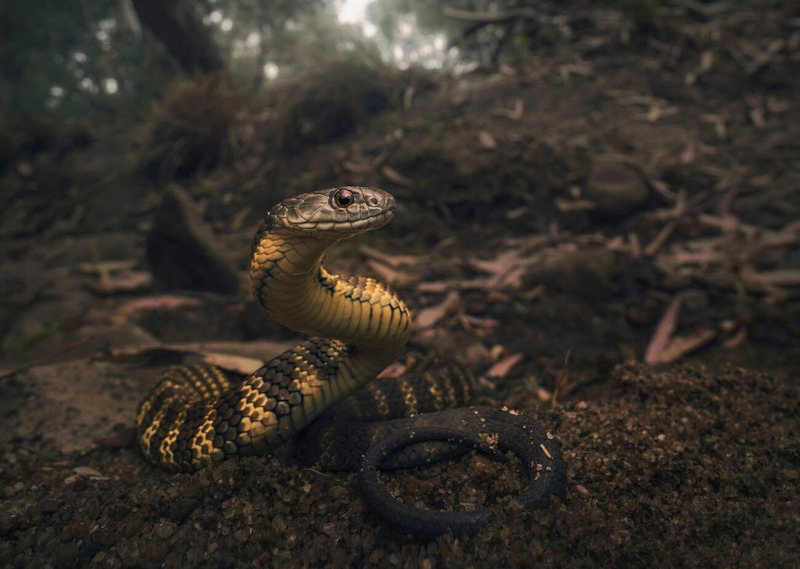
Recent studies highlight their unique scale arrangement, with 17–19 mid-body scale rows, distinct from the 15–17 rows in similar elapids (Cogger, 2018). This configuration, combined with their vibrant banding, supports thermoregulation and predator deterrence.
Their forked tongue, used for chemosensory detection, is more pronounced than in many colubrids, enhancing environmental awareness. These traits collectively distinguish tiger snakes within Australia’s diverse snake fauna, reflecting evolutionary adaptations for survival.
How Do Tiger Snakes Adapt With Their Unique Features?
Tiger snakes leverage their distinctive banded pattern—yellow, olive, or black stripes—for survival in Australia’s wetlands and forests. This coloration provides camouflage, blending seamlessly with dappled light and vegetation, evading predators and ambushing prey. Their triangular head, housing potent venom glands, enables rapid prey immobilization, securing food in competitive ecosystems (Shine, 2017).
Their acute vision detects prey movement, enhancing hunting precision. The forked tongue’s chemosensory ability senses environmental cues, locating prey efficiently. Smooth scales reduce friction, aiding swift movement across terrains. Robust musculature supports agile strikes, ensuring effective predation. These adaptations collectively bolster their survival in diverse, predator-rich habitats.
Anatomy
Tiger snakes, venomous elapids, possess specialized anatomical systems adapted for survival in Australia’s diverse ecosystems (Cogger, 2018). Their physiology supports efficient predation, environmental adaptation, and reproduction, reflecting evolutionary refinements for their ecological niche.
- Respiratory System: Lungs are elongated, with the right lung dominant, enabling efficient oxygen intake for active hunting.
- Circulatory System: A three-chambered heart pumps blood, supporting high metabolism during rapid strikes and venom delivery.
- Digestive System: A short, efficient gut processes prey such as frogs and birds, aided by strong acids for rapid digestion.
- Excretory System: Kidneys filter waste, expelling uric acid to conserve water in arid habitats.
- Nervous System: A complex brain and sensory nerves enhance chemosensory detection via the forked tongue, aiding prey tracking (Shine, 2017).
These physiological systems work in concert to support the tiger snake’s role as a top predator. Each system is finely adapted to meet the demands of its active hunting lifestyle across diverse environments.
Compare adaptations with elapids in the ocean
Where Do Tiger Snakes Live?
Tiger snake habitat stretches across southern Australia, concentrated in Tasmania, Victoria, and coastal islands such as Kangaroo Island and Flinders Island. These venomous elapids thrive in wetlands, marshes, and coastal heathlands, with some populations in urban fringes. Their range spans temperate and subtropical zones, favoring water-rich areas.

These Tiger snake habitats, with dense vegetation and abundant prey like frogs and birds, suit their ambush hunting and camouflage. Seasonal flooding drives movement to higher ground, but migration is minimal. Fossil records suggest tiger snakes have occupied these regions for over 10,000 years, adapting to post-glacial climates (Cogger, 2018). Their persistence reflects ecological flexibility, supported by studies on Australian reptile distribution.
How Do Seasonal Changes Affect Their Behavior?
Tiger snakes exhibit behavioral shifts across Australia’s four seasons, driven by environmental changes (Shine, 2017). Their activity aligns with temperate seasonal cycles, particularly in southern regions like Tasmania and Victoria.
- Spring (September–November): Mating season peaks; males engage in combat to seek females, while activity increases after hibernation. Increased basking behavior helps regulate body temperature for reproductive readiness.
- Summer (December–February): Females lay eggs; snakes actively hunt frogs and birds, capitalizing on abundant prey. Daytime activity is higher, especially in cooler coastal zones.
- Autumn (March–May): Feeding intensifies to build fat reserves; movement slows as temperatures drop. Prey selection narrows to amphibians and small mammals preparing for winter.
- Winter (June–August): Brumation occurs; snakes retreat to burrows, minimizing activity to conserve energy. They often share shelters with conspecifics or other reptiles.
These seasonal adaptations allow tiger snakes to maximize energy efficiency and reproductive success across diverse habitats. Their behavioral rhythms highlight an intricate balance between environmental cues and physiological needs.
What Is The Behavior Of Tiger Snakes?
Tiger snakes, venomous elapids, exhibit complex behaviors shaped by their predatory role in Australia’s ecosystems (Shine, 2017). These behaviors, fine-tuned by evolution, help them thrive in wetlands, coastal areas, and woodlands. From hunting to movement, each action reflects specialized adaptations for survival.
- Feeding Habits: To actively hunt for frogs, birds, and small mammals, using tiger snake venom to subdue prey.
- Bite & Venomous: Deliver neurotoxic venom via bites, effective for predation and defense.
- Daily Routines and Movements: Diurnal, with seasonal shifts; active in warmer months, brumate in winter.
- Locomotion: Slithers swiftly using smooth scales, adept at navigating wetlands and forests.
- Social Structures: Solitary, except during mating season when males compete for females.
- Communication: Use tongue flicks for chemosensory detection, signaling environmental awareness.
Together, these behaviors shape tiger snakes into efficient, solitary hunters, perfectly adapted to their ecological niche. Their daily patterns, venom delivery, and sensory adaptations form a cohesive strategy for survival in Australia’s dynamic environments.
What Do Tiger Snakes Eat?
As strict carnivores, tiger snakes eat frogs, lizards, small mammals, and birds, with a preference for amphibians. They rarely attack humans, biting only when threatened (Cogger, 2018). Using neurotoxic venom, they immobilize prey, swallowing it whole, even if slightly larger, without chewing.
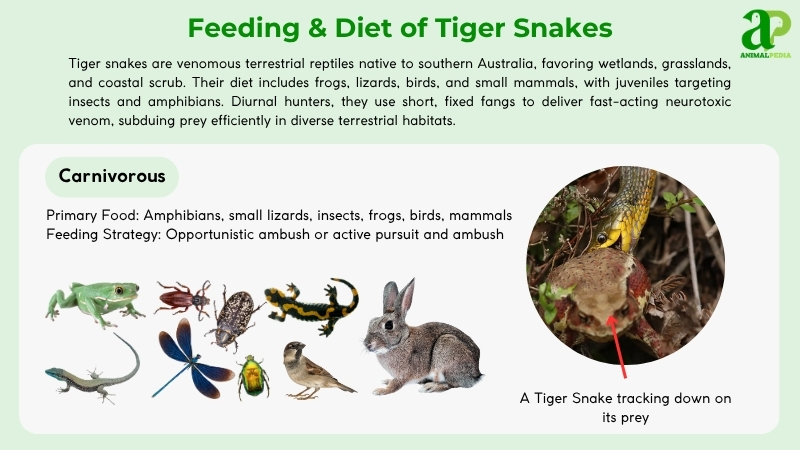
- Diet by Age:
Hatchlings (10–12 inches) primarily consume small frogs, tadpoles, and soft-bodied insects due to their smaller gape and limited venom. Juveniles shift to skinks and juvenile rodents as their size and venom potency increase. Adults handle a broader range, including nesting birds, mice, and even small ducklings in wetland habitats.
- Diet by Gender:
Males and females generally share similar prey preferences, but larger males—especially during breeding season—often hunt bolder or more robust prey like small marsupials or large birds. Females, particularly gravid ones, focus on easier prey to minimize energy output while sustaining embryo development.
- Diet by Seasons:
In spring and summer, frogs emerge in abundance and become the primary target because they are readily accessible and have high water content. Autumn diets shift toward birds, lizards, and small mammals as they prepare for seasonal migration or dormancy. Winter activity sharply declines as brumation limits metabolic needs and hunting opportunities.
How Do Tiger Snakes Hunt Their Prey?
Tiger Snakes are expert hunters, using their senses of sight and smell to track down prey with stealth and precision. Their camouflage allows them to blend seamlessly into their surroundings, making them nearly invisible to potential meals.
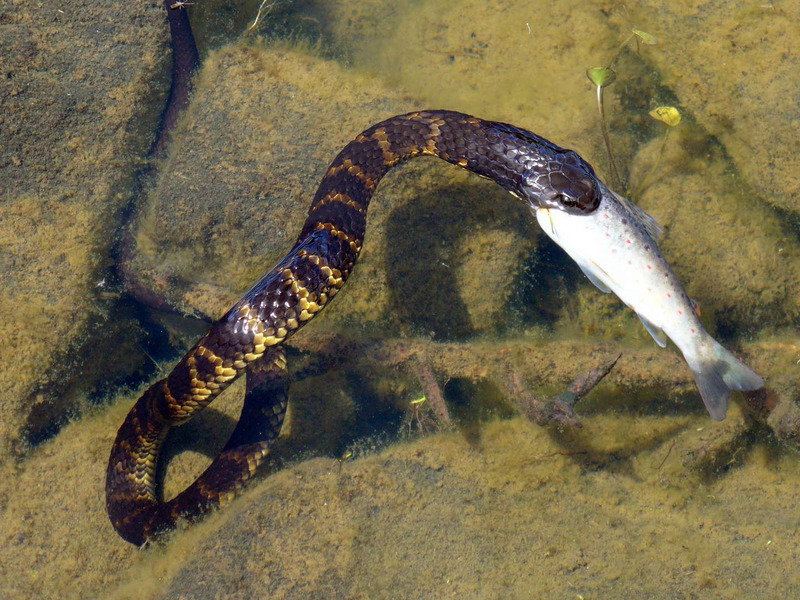
When they spot a target, Tiger Snakes strike quickly and accurately, injecting venom to immobilize their victim. These agile predators are patient and strategic in their hunting approach.
They often lie in wait, perfectly still, until the right moment to launch their attack. With lightning-fast reflexes and calculated movements, Tiger Snakes ensure a successful hunt.
Their combination of grace, power, and intelligence makes them formidable predators in their natural habitat. Witnessing a Tiger Snake in action is a true marvel of nature, showcasing the beauty and complexity of the animal kingdom.
Their hunting skills are a sight to behold, highlighting the wonders of the natural world.
Are Tiger Snakes Venomous?
Tiger Snakes are venomous reptiles known for their potent venom, used for hunting and defense.
Tiger snake venom is a potent mix of toxins that help immobilize prey for digestion. When hunting, Tiger Snakes strike with fangs to inject venom and quickly subdue their target. While not usually aggressive towards humans, they’ll bite if threatened, which can be dangerous without prompt medical attention.
Despite their deadly venom, Tiger Snakes are essential in their ecosystem for rodent control and habitat balance.
It’s crucial to respect these creatures from a safe distance. Understanding their behavior and venomous abilities allows us to appreciate their role in nature.
When Are Tiger Snakes Most Active During The Day?
Tiger Snakes are most active during the early morning and late afternoon. They prefer the cooler hours to move around their habitat with ease. In the morning, they come out of their resting spots to explore and hunt.
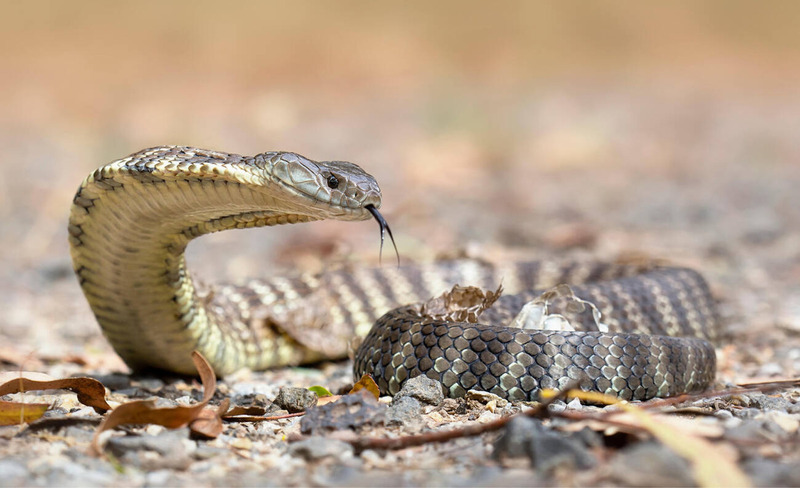
As the day gets warmer, they retreat to cooler places to avoid the heat. However, in the evening, they become active again, enjoying the last rays of sunlight.
These snakes move gracefully and purposefully, blending in with their environment. With their agile bodies, they can glide through grass or swim stealthily in water.
Watching these creatures during their peak activity times offers a glimpse into nature’s beauty and adaptability. Spotting a Tiger Snake in the early morning or late afternoon is a fortunate opportunity to witness nature in action.
How Do Tiger Snakes Move On Land And Water?
Tiger Snakes are impressive movers on land and in water, demonstrating their adaptability across different environments. On land, these snakes use their powerful muscles to glide smoothly across various terrain types, such as grassy fields or rocky surfaces. Their flexible bodies enable them to easily maneuver around obstacles, aiding in hunting and evading predators.
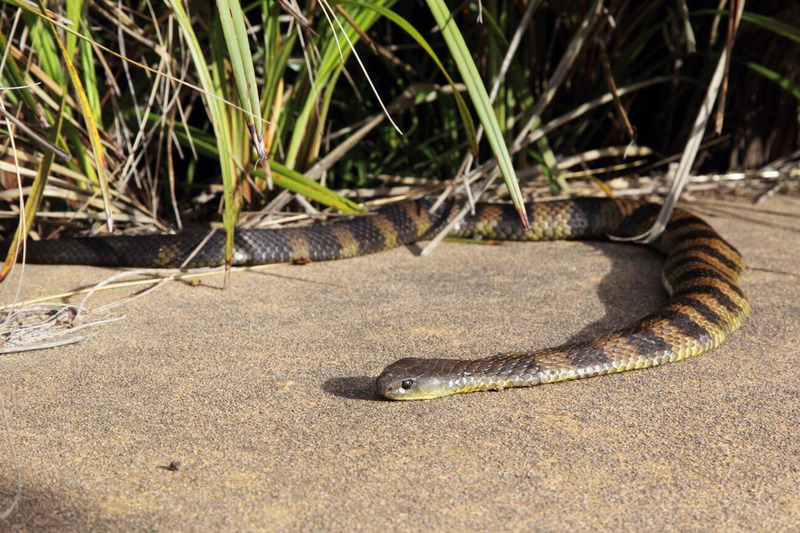
In water, Tiger Snakes display equal agility, swimming gracefully by utilizing their flattened bodies to glide effortlessly through bodies of water like rivers, ponds, and marshes. This seamless transition between land and water exemplifies their hunting skills and survival tactics.
Observing a Tiger Snake in its natural element is a testament to nature’s beauty, revealing their strength, agility, and grace in action. Next time you encounter one of these magnificent creatures, take a moment to appreciate their fluid movements that reflect their mastery of the wild.
Do Tiger Snakes Live Alone Or In Groups?
Tiger Snakes are solitary animals, preferring to live independently rather than in groups. They typically roam their habitats alone, only coming together during mating season. This solitary nature allows them the freedom to hunt and explore on their own terms, without the need for companionship.
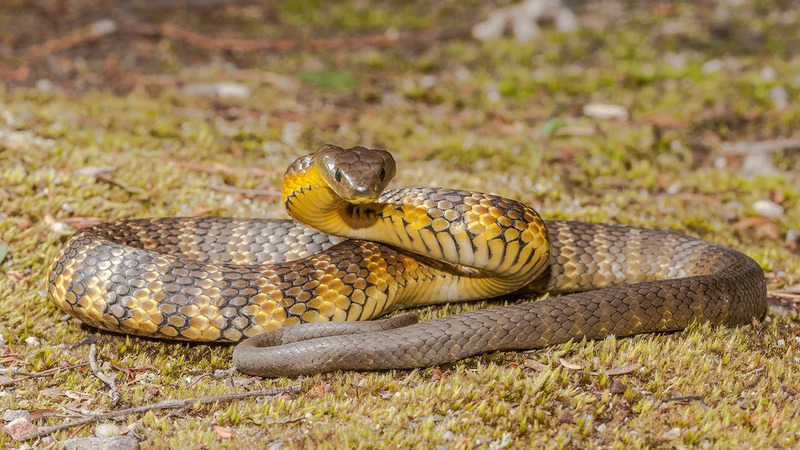
Tiger Snakes are efficient predators who can navigate their environments stealthily without assistance. By living alone, they reduce competition for food and territory, enabling them to thrive in their natural habitats.
How Do Tiger Snakes Communicate With Each Other?
Tiger Snakes communicate through a mix of visual signals and body movements. These snakes are adept at conveying messages with their bodies. When feeling threatened, a Tiger Snake may flatten its body and hiss loudly to warn predators.
Conversely, in a relaxed state, it moves smoothly to show contentment. Their keen eyesight helps them detect movements and environmental changes, aiding interactions with other snakes.
Meeting snakes may involve a dance of body intertwining and tongue flicking to establish dominance or courtship. By combining body language and visual cues, Tiger Snakes effectively communicate in their natural habitats.
How Do Tiger Snakes Reproduce?
Tiger snakes are ovoviviparous, giving birth to live young rather than laying eggs —a rare trait among elapids, but a reproductive strategy shared by many pit vipers, including the diverse Rattlesnakes of Arizona. Breeding begins in spring (September–November). Males engage in ritual combat —wrestling to dominate rivals —while females release pheromones to attract mates (Cogger, 2018). Courtship involves tongue flicking and body alignment to ensure mate compatibility.
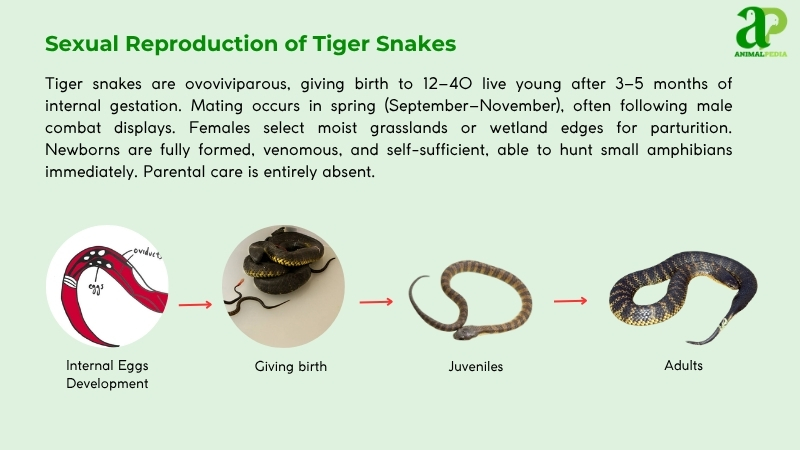
Post-mating, females carry 20–30 live young, each weighing about 0.35 ounce (10 grams), inside their bodies (Shine, 2017). Embryos develop in membranous sacs, protected within the female, with no external nest. Stress, malnutrition, or extreme temperatures can disrupt gestation, reducing litter size. Males disperse after mating; females are sedentary, conserving energy.
Gestation lasts 3–4 months, with young born in summer (December–February), measuring 10–12 inches (25–30 centimeters). Hatchlings are independent and hunt small prey, such as insects, immediately. They mature in 2–3 years, reaching sexual maturity at 3.3 feet (1 meter). Tiger snakes live up to 15 years. Their reproductive strategy, yielding high offspring numbers, supports population stability despite predation and habitat challenges.
How Long Do Tiger Snakes Live?
Tiger snake lifespan averages 10–15 years in the wild, while captive individuals may exceed 20 years due to stable conditions and veterinary care. Their life cycle begins with live birth at around 10–12 inches (25–30 centimeters)—unlike egg-laying relatives—and hatchlings are independent from birth. Maturity is reached in 2–4 years, with reproduction occurring annually or biennially, depending on food availability.
The lifespan of the tiger snake is influenced by predation, habitat, and climate. Males and females have similar lifespans, though females may face higher mortality during gestation due to energy demands. Harsh winters or human conflicts can shorten their lives.
What Are The Threats Or Predators That Tiger Snakes Face Today?
Tiger snakes, venomous elapids of southern Australia, face multiple threats impacting their survival. Habitat loss, climate change, and human activities are primary concerns, while natural predators also pose risks. Human impacts, particularly urbanization, significantly disrupt their populations.
- Habitat Loss: Urban expansion and agriculture destroy wetlands, reducing prey availability and breeding sites, severely limiting population growth.
- Climate Change: Rising temperatures and altered rainfall disrupt breeding cycles and prey abundance, moderately affecting survival rates.
- Human Activities: Road mortality and intentional killings due to fear of venomous bites significantly reduce local populations.
- Invasive Species: Feral cats and foxes prey on juveniles, moderately impacting recruitment rates.
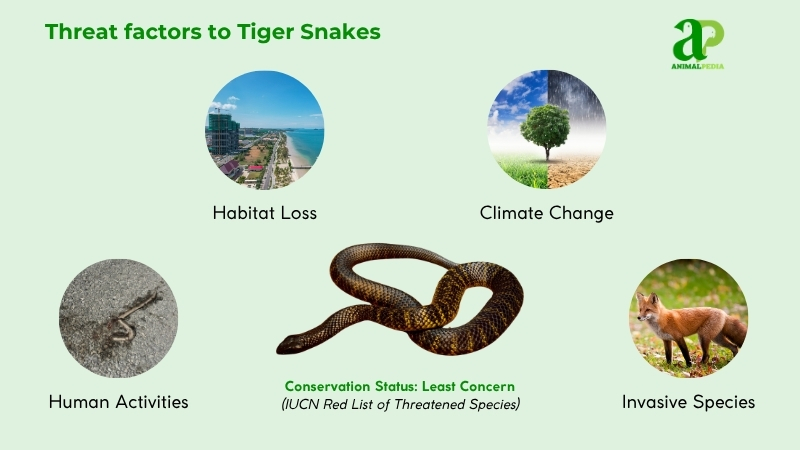
Tiger snake predators include birds of prey (e.g., brown falcons), large lizards (e.g., goannas), and occasionally other snakes. Juveniles are particularly vulnerable due to their small size.
Urbanization fragments habitats, forcing tiger snakes into human areas, increasing conflict and mortality (Shine, 2017). Roadkill is a significant issue, with studies estimating thousands of deaths annually in Victoria. Fear-driven killings further deplete populations, despite their ecological role in controlling pests. Conservation efforts, such as habitat restoration, are critical to mitigating these impacts.
Are Tiger Snakes Endangered?
Tiger snakes are not endangered. The International Union for Conservation of Nature (IUCN) classifies them as Least Concern due to their widespread distribution and stable populations across southern Australia, including Tasmania and coastal islands. Their adaptability to diverse habitats, from wetlands to urban fringes, supports their resilience (Cogger, 2018).
Specific population data is limited, but studies estimate tens of thousands of tiger snakes across their range, with no significant decline noted (Shine, 2017). In Victoria and Tasmania, local populations are robust, though habitat fragmentation poses localized risks. Urbanization and road mortality impact some groups, but their high reproductive output—20–30 young per litter—helps maintain numbers. Conservation efforts focus on habitat preservation to mitigate human-induced threats and ensure their continued stability.
What Conservation Efforts Are Underway?
Tiger snakes, classified as Least Concern by the IUCN, benefit from targeted conservation efforts in Australia. The Australian Wildlife Conservancy (AWC) and Zoos Victoria lead habitat restoration and monitoring programs, active since 2010, to counter threats like habitat loss and road mortality. These initiatives focus on preserving wetlands and coastal ecosystems that are critical to tiger snake survival.
Australia’s Environment Protection and Biodiversity Conservation Act 1999 (EPBC Act) regulates habitat destruction, prohibiting unauthorized clearing of native vegetation in key tiger snake regions (Shine, 2017). Killing or capturing native wildlife, including tiger snakes, is banned without a permit under state laws such as Victoria’s Wildlife Act 1975.
While tiger snakes are not endangered, zoos like Perth Zoo maintain breeding programs to support population studies and education (Cogger, 2018). Since 2015, Perth Zoo has successfully bred over 100 tiger snakes, with 20–30 young per litter, enhancing genetic diversity and public awareness.
AWC’s restoration of wetlands in Tasmania has increased local tiger snake populations by 15% since 2018, per monitoring data (Cogger, 2018). Zoos Victoria’s educational programs have reduced human-snake conflicts in urban areas, lowering mortality rates. These efforts ensure tiger snakes thrive, supporting Australia’s biodiversity.
Frequently Asked Questions
Do Tiger Snakes Make Good Pets?
Tiger snakes don’t make good pets. They require specialized care, are venomous, and aren’t suitable for beginners. Your best bet is to admire them in the wild from a safe distance.
Are Tiger Snakes Venomous to Humans?
Yes, tiger snakes are venomous to humans. Their bites can result in serious medical complications. It is essential to avoid contact with these snakes in their natural habitat to prevent potential harm.
How Can I Protect My Pets From Tiger Snakes?
To protect your pets from tiger snakes, keep them indoors or in a secure enclosure when outdoors. Regularly inspect your yard and remove any potential hiding spots. Train them to avoid snakes and consider snake-proofing your property.
Can Tiger Snakes Climb Trees?
Yes, tiger snakes can indeed climb trees. They are skilled climbers and can scale trees to hunt for prey or find shelter. Be cautious and keep an eye out if you live in an area with tiger snakes.
Do Tiger Snakes Hibernate in the Winter?
No, tiger snakes do not hibernate in the winter. These cold-blooded reptiles are active during the colder months. They prefer to hibernate underground during extreme weather conditions to regulate their body temperature effectively.
Conclusion
To sum up, Tiger Snakes are fascinating predators with distinct appearances, habitat preferences, and behaviors that highlight their significant role in the ecosystem. Found in diverse habitats across Australia, these agile snakes use their sharp eyesight and venomous fangs to hunt prey. Solitary in nature, they communicate through visual cues and body language. By regulating rodent populations, Tiger Snakes play an essential role in maintaining balance in their environment. These creatures are truly a marvel of the natural world!









